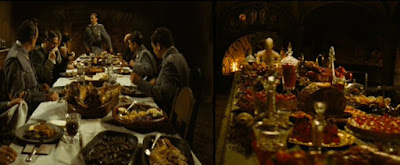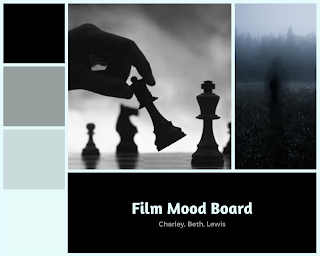La La Land Cinematography
Discuss how important cinematography is in establishing strong responses from spectators to a key character in La La Land.
Of the scenes in La La Land, the one in which I will be focusing on is from after Mia and Sebastian break up - in it I will focus on Sebastian, I chose this scene because in this point of the movie, I believe the characters become more relatable.
The scene begins with long shot of a wedding, as the camera pans anti-clockwise we see couples dancing and sitting then it stops at Sebastian playing the piano and pans forward. By panning the camera around the audience, the audience can notice that Sebastian is the only one alone at the wedding, this highlights how lonely Sebastian must feel, since all around him are happy couples while he has recently experienced heartbreak. An audience member may identify with this scene, because many people have to go to weddings when they're single, and most people experience terrible break ups. If the camera had just shown Sebastian playing the piano, and not the party around him, then we would have less of an understanding on how lonely his feels, and might even see the scene as positive, since weddings are seen as happy times for celebration. There is then a cut to the married couple kissing happily and dancing when Sebastian is looking up at them from the piano, this is used to further convey his loss of love and feelings of loneliness. Then the movie focuses back on Sebastian at the piano with the camera panning closer to him as he looks back at what he's playing. When you compare the two shots, the first of the couple, then with the shot of Sebastian playing piano, an active audience member may see that in the background of the couple there are other people dressed in light, bright colours, while in contrast the background of Sebastian only has the dark green bushes and pathway. By comparing the two, Sebastian is further shown to be isolated and dark, opposed to the cheerful atmosphere of the party. When Sebastian finishes playing, the camera stops at a mid-shot of him and stays on that shot of him as the audience erupts into applause - this is significant, because instead of showing the audience's reaction, we see Sebastian's reaction to the applause. The effect of this is it separates Sebastian from the party and it's the first time in the movie (so far) his piano playing alone has gotten him praise, which could set up how the break up between Sebastian and Mia results in their individual success, preparing the audience for the bittersweet ending - this may be picked up on by an active audience member, or by multiple viewings. Also, this may make the audience feel happy that Sebastian is getting the praise he worked for, though it is also meaningless since its from his friends that would cheer him on anyway. When I watched this scene, I took a preferred reading by feeling sympathetic towards Sebastian, since with the use of cinematography Chazelle illustrates to the watcher Sebastian's isolation from the party, because of the termination of his relationship with Mia. While watching the scene, you may realise that Sebastian most likely planned on bringing Mia to the party with him, since they were together when the couple got engaged, which conveys more of a reason as to why Sebastian is so upset.
That is how that scene ends, with the scene at the party fading to black. As his phone begins to ring, there is a cut to a long shot of Sebastian lying in bed. All of the lighting in this scene comes from a single window with horizontal blinds, which makes his room look dark and upsetting, and with the blinds possibly looking like prison bars, implying that he feels trapped in his isolation. With the use of this shot, we see how dark Sebastian's life has become without Mia - this induces feelings of sympathy in watchers. As Sebastian answers the phone, the camera begins to pan forward towards Sebastian, as if it is trying to listen to the conversation. This could also convey hope beginning to grow within Sebastian, with what the call is about - Mia's new audition.
The effect of these two scenes is to present Sebastian after the break up, so Chazelle decides to illustrate using the cinematography how alone Sebastian feels, with the use of lighting and panning, we get to see the world how Sebastian sees it for a while, which helps the audience recognise and identify with the character.
Of the scenes in La La Land, the one in which I will be focusing on is from after Mia and Sebastian break up - in it I will focus on Sebastian, I chose this scene because in this point of the movie, I believe the characters become more relatable.
The scene begins with long shot of a wedding, as the camera pans anti-clockwise we see couples dancing and sitting then it stops at Sebastian playing the piano and pans forward. By panning the camera around the audience, the audience can notice that Sebastian is the only one alone at the wedding, this highlights how lonely Sebastian must feel, since all around him are happy couples while he has recently experienced heartbreak. An audience member may identify with this scene, because many people have to go to weddings when they're single, and most people experience terrible break ups. If the camera had just shown Sebastian playing the piano, and not the party around him, then we would have less of an understanding on how lonely his feels, and might even see the scene as positive, since weddings are seen as happy times for celebration. There is then a cut to the married couple kissing happily and dancing when Sebastian is looking up at them from the piano, this is used to further convey his loss of love and feelings of loneliness. Then the movie focuses back on Sebastian at the piano with the camera panning closer to him as he looks back at what he's playing. When you compare the two shots, the first of the couple, then with the shot of Sebastian playing piano, an active audience member may see that in the background of the couple there are other people dressed in light, bright colours, while in contrast the background of Sebastian only has the dark green bushes and pathway. By comparing the two, Sebastian is further shown to be isolated and dark, opposed to the cheerful atmosphere of the party. When Sebastian finishes playing, the camera stops at a mid-shot of him and stays on that shot of him as the audience erupts into applause - this is significant, because instead of showing the audience's reaction, we see Sebastian's reaction to the applause. The effect of this is it separates Sebastian from the party and it's the first time in the movie (so far) his piano playing alone has gotten him praise, which could set up how the break up between Sebastian and Mia results in their individual success, preparing the audience for the bittersweet ending - this may be picked up on by an active audience member, or by multiple viewings. Also, this may make the audience feel happy that Sebastian is getting the praise he worked for, though it is also meaningless since its from his friends that would cheer him on anyway. When I watched this scene, I took a preferred reading by feeling sympathetic towards Sebastian, since with the use of cinematography Chazelle illustrates to the watcher Sebastian's isolation from the party, because of the termination of his relationship with Mia. While watching the scene, you may realise that Sebastian most likely planned on bringing Mia to the party with him, since they were together when the couple got engaged, which conveys more of a reason as to why Sebastian is so upset.
That is how that scene ends, with the scene at the party fading to black. As his phone begins to ring, there is a cut to a long shot of Sebastian lying in bed. All of the lighting in this scene comes from a single window with horizontal blinds, which makes his room look dark and upsetting, and with the blinds possibly looking like prison bars, implying that he feels trapped in his isolation. With the use of this shot, we see how dark Sebastian's life has become without Mia - this induces feelings of sympathy in watchers. As Sebastian answers the phone, the camera begins to pan forward towards Sebastian, as if it is trying to listen to the conversation. This could also convey hope beginning to grow within Sebastian, with what the call is about - Mia's new audition.
The effect of these two scenes is to present Sebastian after the break up, so Chazelle decides to illustrate using the cinematography how alone Sebastian feels, with the use of lighting and panning, we get to see the world how Sebastian sees it for a while, which helps the audience recognise and identify with the character.


Comments
Post a Comment